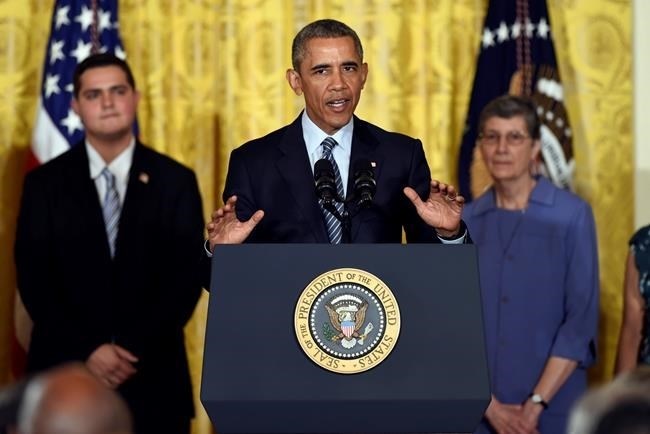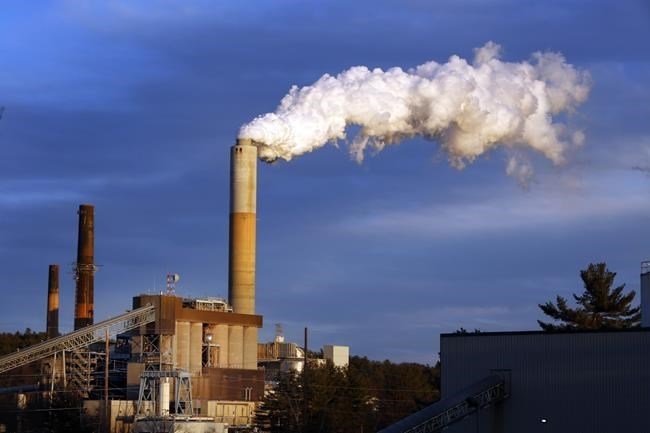
President Barack Obama speaks about his Clean Power Plan, Monday, Aug. 3, 2015, in the East Room at the White House in Washington. The president is mandating even steeper greenhouse gas cuts from U.S. power plants than previously expected, while granting states more time and broader options to comply.
Image Credit: AP Photo/Susan Walsh
August 03, 2015 - 1:00 PM
WASHINGTON - President Barack Obama says his new power plant regulations are "the single most important step" America has ever taken in the fight against climate change.
The president's plan requires states to cut carbon dioxide emissions by 32 per cent by 2030.
Obama says he is convinced that no challenge poses a greater threat to "our future and future generations" than a changing climate. He says the U.S. can't risk being too late in stopping the effects of climate change.
Opponents plan to sue to stop the rule.
A look at potential winners and losers in Obama's final plan:
WINNERS:
— ENVIRONMENTALISTS
To the delight of environmental groups, Obama tightened the emissions requirements in his final plan. That means power plants will have to attain an even lower level of carbon dioxide pollution to be in compliance. Obama's proposal from last year set the target as a 30 per cent nationwide cut by 2030, compared to the levels in 2005. His revamped plan calls for a 32 per cent cut in the same time period.
Left unchanged is Obama's overall goal for U.S. emissions cuts from all sources of pollution, including cars and trucks. As the U.S. commitment to a major global climate treaty that Obama is championing, the U.S. committed to cutting its emissions 26 per cent to 28 per cent by 2030, compared to 2005.
— PROCRASTINATING STATES
Many of the complaints directed at Obama's plan over the last year centred on the amount of time states would have to figure out how to meet their targets. Plans for how states will comply are technically due next year, but there's no penalty to asking for a two-year extension, so most states are expected to delay. Under the earlier plan, the rock-bottom deadline was 2017, but that's being pushed back to 2018.
And while states previously had until 2020 to achieve their targets, they'll now have an extra two years — until 2022.
— RENEWABLE ENERGY
Obama's revised plan relies more heavily on renewable energy sources like wind and solar replacing dirtier coal-fired power plants. Obama now wants the U.S. to get 28 per cent of its power from renewables by 2030, compared to 22 per cent in his earlier proposal.
In a new element, the administration now intends to offer pollution credits to states that drive up renewable energy generation in 2020 and 2021 ahead of the compliance deadline. States that invest early in wind and solar can store away those credits to offset pollution emitted after the compliance period starts in 2022.

In this Jan. 20, 2015 file photo, a plume of steam billows from the coal-fired Merrimack Station in Bow, N.H.
Image Credit: AP Photo/Jim Cole, File
LOSERS:
— NATURAL GAS
The earlier version of Obama's plan sought to accelerate the ongoing shift from coal-fired power to natural gas, which emits far less carbon dioxide. But the final rule aims to keep the share of natural gas in the nation's power mix the same as it is now.
EPA Administrator Gina McCarthy said government estimates show renewable energy has ticked upward even since the rule was proposed last year, but that natural gas remained an important part of the U.S. energy mix.
— ENERGY EFFICIENCY
Under the revamped plan, state energy efficiency efforts are no longer factored into the individualized reduction targets being assigned to each state. In other words, what states are already doing to reduce energy demand won't be included in their baseline the way that other measures, like replacing coal plants with cleaner sources, will be. That means some states could face more stringent targets despite their efforts in the past to cut down on electricity use.
But states will still be able to get credit for energy efficiency programs when it comes to meeting their targets in 2022. The revised power plant rule also offers polluting credits to states that deploy energy efficiency programs in poorer communities.
INCONCLUSIVE:
— POWER BILL
Although the administration predicts the plan will actually lower the average U.S. energy bill by almost $85 in 2030, companies that produce and distribute electricity aren't buying it. The savings come largely from increased use of wind, power and hydro plants, which operate at a cost of close to zero after they're installed but cost a lot to get up and running. The administration is also counting on people's power bills going because they'll simply use less power as a result of efficiency measures.
The National Association of Manufacturers, the American Coalition for Clean Coal Electricity, the National Mining Association, the American Energy Alliance and the National Rural Electric Cooperative Association all predicted the rule would drive electricity bills up. But the Georgia Tech School of Public Policy and the research firm Synapse Energy Economics have published analyses of the proposed rule that back up Obama's claim that power bills will go down.
News from © The Associated Press, 2015